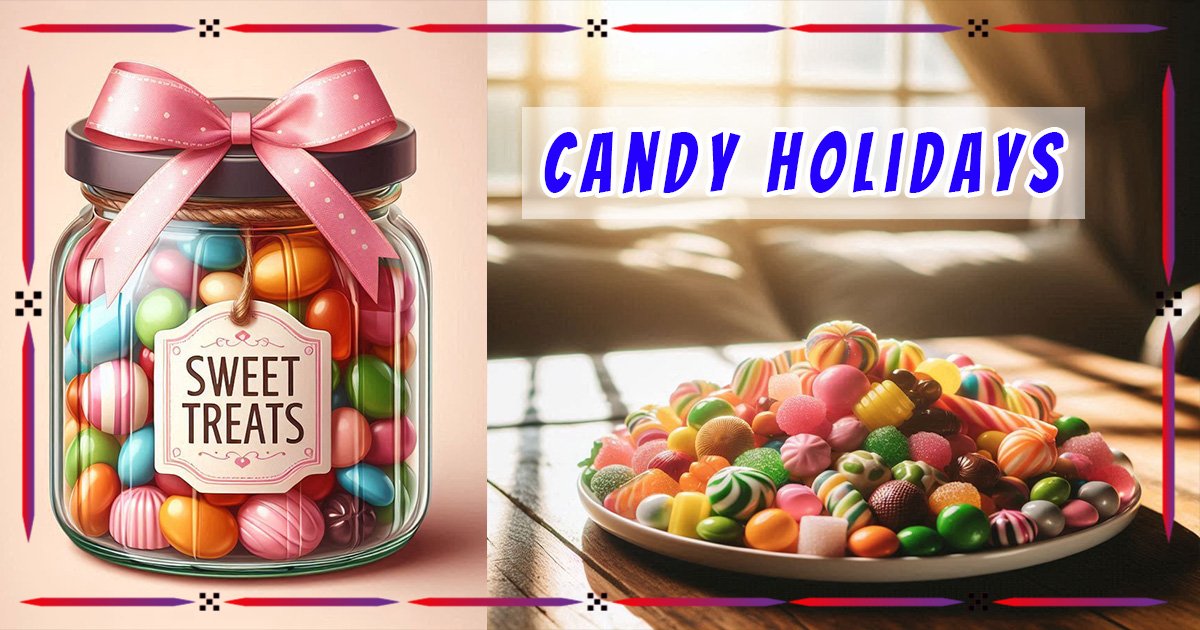Candy is a treat that often brings joy to both children and adults. Around the world, various holidays are strongly associated with candy, where sweets play a key role in the celebration. From Halloween to Easter, candy has become an integral part of these events, delighting people and adding to the festive spirit. In this post, we’ll explore which holiday is associated with candy, why candy is important in these celebrations, and how these traditions evolved over time.
Top Holidays Associated with Candy
Several holidays are closely associated with candy, but the following events stand out as major candy-filled occasions:
- Halloween
Halloween is undoubtedly the top holiday associated with candy. Every October 31st, children and adults alike participate in “trick-or-treating,” where kids dress up in costumes and go door-to-door collecting candy. Some of the most popular Halloween candies include chocolate bars, candy corn, gummies, and lollipops.
The association of Halloween with candy started in the early 20th century. Initially, fruits, nuts, and coins were given out, but by the 1950s, candy manufacturers capitalized on the holiday, making it one of the biggest candy-selling events of the year.
- Easter
Easter is another major holiday known for its association with candy, particularly chocolate. Easter egg hunts are a popular tradition where children search for eggs, often filled with candy. Chocolate eggs, bunnies, jelly beans, and marshmallow treats are staples of the Easter season.
The symbolism of eggs during Easter dates back centuries, representing new life and rebirth. The tradition of giving candy, particularly chocolate eggs, grew in popularity in the 19th century and continues to this day.
- Valentine’s Day: Which Holiday is Associated with Candy for Romance?
Valentine’s Day, celebrated on February 14th, is a holiday associated with love and romance. Candy, particularly chocolates, plays a central role in expressing affection. Heart-shaped boxes filled with chocolates and sugary confections are commonly exchanged between couples, friends, and family members.
The tradition of giving candy on Valentine’s Day has roots in the Victorian era when chocolate was seen as a luxurious gift. Today, companies like Godiva and Hershey’s create elaborate candy collections specifically for the holiday.
- Christmas
During the Christmas season, candy takes many forms—from candy canes to chocolates and peppermint-flavored treats. Stocking stuffers often include candy, and many families exchange sweet treats as part of their holiday traditions.
Candy canes, one of the most iconic Christmas candies, are said to represent the shepherd’s crook in Christian traditions. Other popular Christmas candies include chocolate-covered fruits, fudge, and caramel.
- Día de los Muertos
Día de los Muertos, or the Day of the Dead, is a Mexican holiday celebrated on November 1st and 2nd. During this time, families honor deceased loved ones with colorful altars, food, and candy. One of the most iconic sweets associated with this holiday is “sugar skulls,” which are intricately decorated and often placed on altars.
Though not as candy-focused as Halloween or Easter, the significance of sugar-based treats during Día de los Muertos is profound. The sugar skulls are meant to represent the deceased, offering a sweet remembrance of their life.
How Candy Became an Integral Part of These Holidays
The connection between candy and holidays is rooted in a mix of tradition, commerce, and symbolism. Early celebrations of holidays like Halloween and Christmas included giving out simple treats like fruits and nuts. Over time, candy became the preferred treat due to its long shelf life, availability, and marketing by major candy companies.
- Commercial Influence: In the 20th century, candy manufacturers played a huge role in cementing the association of candy with holidays. For instance, companies like Mars and Nestle created themed candy specifically for holidays, and clever advertising helped make sweets a central part of holiday celebrations.
- Cultural Significance: In addition to marketing, candy holds symbolic meaning in many cultures. For example, candy canes represent purity and sacrifice in Christian Christmas traditions, while sugar skulls during Día de los Muertos symbolize remembrance and honor for the dead.
Top 5 Most Popular Holiday Candies
- Reese’s Peanut Butter Cups (Halloween): A top choice during Halloween, these chocolate and peanut butter treats are a favorite in trick-or-treat bags.
- Cadbury Creme Eggs (Easter): These rich, chocolate eggs with a sweet filling are a staple during the Easter season.
- Conversation Hearts (Valentine’s Day): With sweet messages printed on each piece, these colorful candies are a symbol of love during February.
- Candy Canes (Christmas): Peppermint-flavored candy canes are a beloved Christmas treat, often used as both decoration and a sweet indulgence.
- Sugar Skulls (Día de los Muertos): Intricately decorated sugar skulls are both a visual and sweet delight during the Day of the Dead.
Health Considerations: Moderation is Key
While candy is a big part of holiday celebrations, it’s important to enjoy it in moderation. Consuming too much sugar can lead to health issues, including weight gain and an increased risk of diabetes. Many nutritionists recommend indulging in candy only during special occasions and balancing it with a healthy diet.
According to The American Heart Association, the recommended daily sugar intake should not exceed 25 grams for women and 36 grams for men. Holidays often lead to overconsumption of sweets, so keeping track of candy intake is essential.
Candy Alternatives for a Healthier Holiday
If you’re looking for healthier alternatives to candy during holiday celebrations, consider these options:
- Fruit-based Treats: Swap candy for dried fruit or fruit snacks. These are naturally sweet and can still satisfy sugar cravings.
- Dark Chocolate: Opt for dark chocolate instead of milk chocolate. Dark chocolate contains less sugar and offers health benefits like antioxidants.
- Homemade Treats: Make homemade sweets with less sugar. You can create your own cookies, granola bars, or even candy using healthier ingredients like honey or agave syrup.
For more tips on reducing sugar intake during the holidays, check out Healthline.
The Role of Candy in Modern Marketing
Candy plays a significant role in holiday marketing campaigns. From Halloween-themed packaging to Valentine’s Day chocolate hearts, candy companies have mastered the art of seasonal marketing. Holidays offer a prime opportunity for brands to boost sales through limited-edition products and festive packaging.
For example, candy manufacturers like Hershey’s and Mars create unique variations of their popular products, specifically for certain holidays. Limited-edition flavors, such as pumpkin-spiced chocolates or holiday-themed wrappers, add excitement and exclusivity, driving more sales during these periods.
The tradition of gifting candy during holidays also allows marketers to target emotional connections, associating their products with love, celebration, and togetherness. This strategy has proven highly effective, as seen in the billions of dollars generated by candy sales during the holiday season.
The Environmental Impact of Holiday Candy
While candy brings joy to many holiday celebrations, it’s important to consider its environmental impact. Candy wrappers, often made of non-recyclable plastic, contribute to significant waste during holidays like Halloween and Christmas. Millions of candy wrappers are discarded each year, adding to landfill pollution.
In recent years, some companies have begun exploring more eco-friendly packaging solutions. Brands like Alter Eco and Tony’s Chocolonely offer sustainable packaging for their candy products, making them a better choice for environmentally conscious consumers.
Additionally, making small changes, such as opting for bulk candy or choosing treats with recyclable packaging, can help reduce the environmental footprint of holiday celebrations.
Conclusion: Why Candy is an Essential Part of Holiday Celebrations
From Halloween to Easter, candy has become an essential part of holiday celebrations around the world. Whether it’s the excitement of trick-or-treating or the joy of finding chocolate eggs, candy adds a fun and festive element to each occasion. While moderation is important, indulging in sweet treats during these special times is a tradition that brings people together.
Visit our homepage for more useful blogs
FAQs
- Which holiday sells the most candy?
- Halloween is the top holiday for candy sales, with billions of dollars spent on sweets each year.
- Why is candy given on Halloween?
- The tradition of giving candy on Halloween began in the 20th century and was popularized by candy companies in the 1950s.
- What is the most popular Valentine’s Day candy?
- Chocolate, particularly in heart-shaped boxes, is the most popular candy for Valentine’s Day.
- How many pounds of candy are eaten each Halloween?
- It’s estimated that Americans consume about 600 million pounds of candy during the Halloween season.
- What is the origin of candy canes at Christmas?
- Candy canes originated in the 17th century and are said to symbolize the shepherd’s crook, representing the shepherds who visited baby Jesus.
- Are there any sugar-free candy options for holidays?
- Yes, many candy companies now offer sugar-free alternatives for popular holiday treats, such as sugar-free chocolate or hard candies.
- What is the healthiest candy to eat during the holidays?
- Dark chocolate is considered one of the healthiest options due to its lower sugar content and antioxidant benefits.
- How can I make holiday candy healthier?
- You can make healthier holiday candies by using natural sweeteners like honey or maple syrup and opting for recipes with whole ingredients.
- Are candy-related holidays celebrated worldwide?
- While holidays like Halloween and Easter are heavily associated with candy in the U.S., similar celebrations with sweets exist in many cultures around the world.

I’m Emma Rose, the founder of tryhardguides.co.uk, and a content creator with a passion for writing across multiple niches—including health, lifestyle, tech, career, and personal development. I love turning complex ideas into relatable, easy-to-digest content that helps people learn, grow, and stay inspired. Whether I’m sharing practical tips or diving into thought-provoking topics, my goal is always to add real value and connect with readers on a deeper level.
Discover more from Try Hard Guides
Subscribe to get the latest posts sent to your email.

